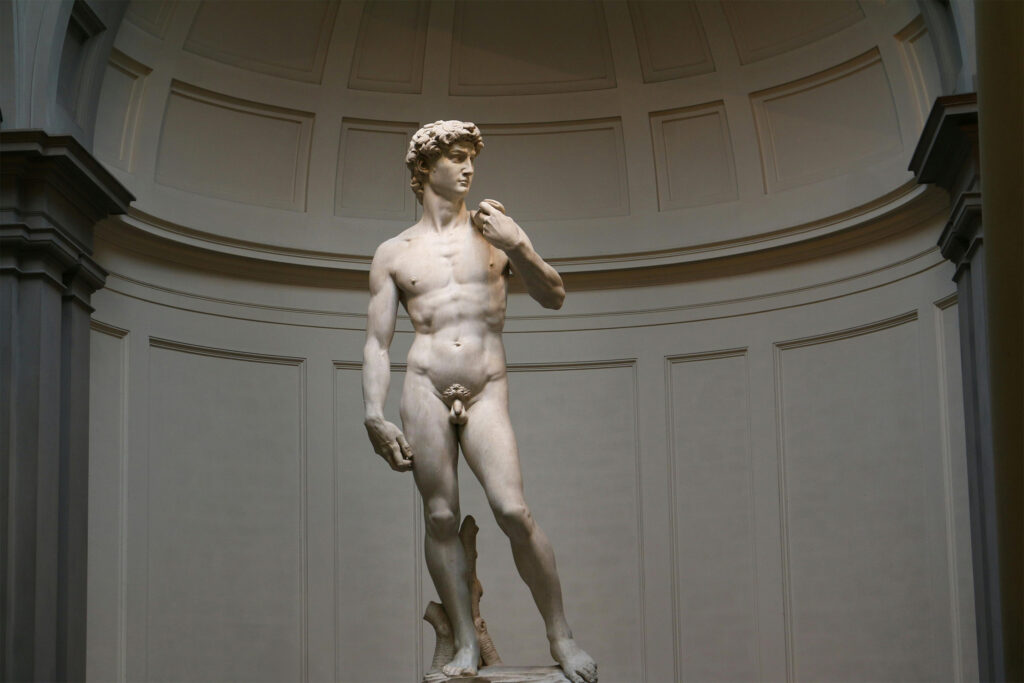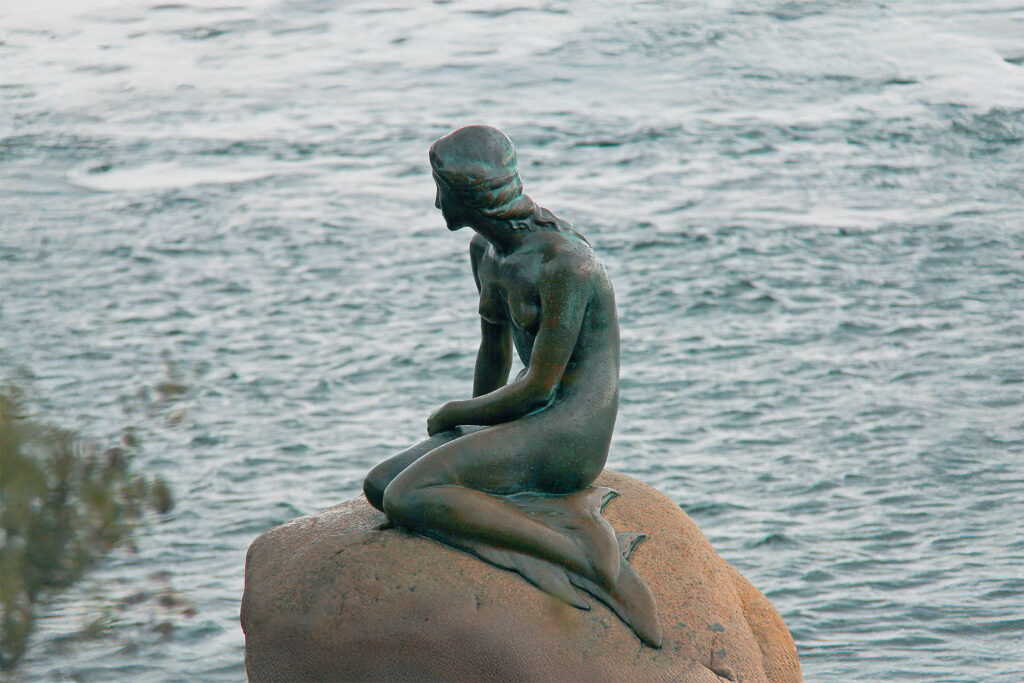Europe is home to an unparalleled wealth of art, with cities adorned by Europe’s famous sculptures attracting millions of visitors each year. These iconic statues of Europe, from colossal monuments to delicate classical works of art, tell the story of European sculptures, making them must-see cultural tourism landmarks in Europe. In this article, we explore the most visited sculptures in Europe, highlighting their legacy and relevance in world art. Below, we present ten of the best sculptures in Europe and their impact on the history of art.
Michelangelo’s David (Florence, Italy)
The David is one of the most famous Renaissance sculptures in history. Michelangelo Buonarroti created this impressive work of art between 1501 and 1504. The sculpture is 5.17 meters high and he carved a single block of Carrara marble to shape it, making it one of the most recognizable marble sculptures in the world. It is located in the Galleria dell’Accademia in Florence, in the heart of art in Europe.
Initially, they commissioned the sculpture for the cathedral of Santa Maria del Fiore, but reconsidered its location due to its artistic perfection.Finally, it was placed in the Piazza della Signoria until 1873, when it was moved to its current location to ensure its preservation.

Rodin’s Thinker (Paris, France)
Located in the Rodin Museum in Paris, Rodin’s The Thinker is one of the most recognized sculptures in France. Conceived between 1881 and 1882, it was originally part of the sculptural ensemble The Gate of Hell, a work inspired by Dante Alighieri’s Divine Comedy.
This human figure symbolizes the human being’s capacity to reflect and create.For this reason, Auguste Rodin turned it into an independent sculpture in 1904, consolidating it as an icon of modern art. Nowadays, numerous copies are found in different sculpture museums in Europe.
The Little Mermaid (Copenhagen, Denmark)
Inspired by Hans Christian Andersen’s fairy tale, The Little Mermaid is a bronze statue located in the port of Copenhagen. Created in 1913 by Edvard Eriksen, it represents the tragic heroine who longs to become human. With a height of 1.25 meters, despite its size, it is one of the most famous sculptures in the world.
It has been vandalized on multiple occasions, even losing its right hand, but has always been restored.Its location by the sea makes it one of the most emblematic historical statues of cultural tourism in Europe.

Michelangelo’s Moses (Rome, Italy)
Located in the church of San Pietro in Vincoli, Michelangelo’s Moses is one of the most impressive sculptures in Italy. Carved in marble between 1513 and 1515, it is part of the funerary monument of Pope Julius II.
One of the most striking aspects is the presence of horns on Moses’ head, the result of a mistranslation of the Bible. On the other hand, its expression of tension and energy makes it one of the most striking works of the 19th century, with a technical execution that continues to amaze historians and art experts in Europe.
The Horses of Marly (Paris, France)
Designed by Guillaume Coustou in the 19th century, these marble horses were created for the Marly Palace. They represent the struggle between a man and a horse, capturing equine strength and majesty with great mastery. They are located in the Louvre Museum, a reference of the art galleries in Paris.
Originally, these sculptures decorated the entrance of the palace, but after the French Revolution, they were moved to the Champs Elysées and later to the Louvre for conservation.
The Victory of Samothrace (Paris, France)
Considered one of the finest classical sculptures, this imposing Hellenistic work depicts the goddess Nike landing on the bow of a ship. It is located in the Daru staircase of the Louvre Museum and is one of the most iconic sculptures in history.
Discovered in 1863 on the island of Samothrace, her influence is evident in many works of modern art. Its dynamic pose and masterful depiction of movement make it one of the most influential works of art of all time.

The Fountain of Neptune (Bologna, Italy)
Located in Piazza del Nettuno in Bologna, this impressive bronze statue was created by Giambologna in the 16th century. It depicts the god Neptune holding his trident, surrounded by allegorical figures of mermaids and children.
It is an emblem of papal power and of the Church’s dominion over the oceans. In fact, they have restored the sculpture on several occasions, and it remains one of the most admired Renaissance sculptures in Italy.
The Columbus Monument (Barcelona, Spain)
The monument is located in the Plaza Portal de la Paz, in Barcelona, and was inaugurated in 1888 on the occasion of the Universal Exposition. In addition, with its 60 meters high, it is one of the most representative sculptures of Spain.
Its image of Christopher Columbus pointing out to sea symbolizes his historic voyage to America, thus becoming a symbol of Spain’s colonial past. In addition, its viewpoint offers a privileged view of the port and the center of Barcelona.
The Walking Man by Giacometti (Zurich, Switzerland)
Created in 1961 by Alberto Giacometti, this bronze statue represents an elongated human figure in full walk. Its unmistakable style has made this work one of the most influential in modern art.
One version is in the Kunsthaus in Zurich, being one of the most representative sculptures in Switzerland.Other versions have been auctioned for record figures on the art market.
The Joan of Arc Statue (Reims, France)
Located in the city of Reims, this bronze statue represents Joan of Arc, heroine of the Hundred Years’ War. Paul Dubois created the sculpture in 1896, and it is currently located in front of the cathedral of Reims.
Joan of Arc is one of the most emblematic figures of France, and her equestrian image symbolizes French patriotism. It is also one of the most important sculptures in the country and remains a benchmark of public art in France.
Our work in monumental sculpture
At Capa Esculturas we follow the tradition of creating monumental sculptures that mark cities and emblematic spaces. We work with materials such as bronze and stainless steel, contributing to the legacy of art in Europe with large-scale sculptures that combine tradition and modernity.
If you want to see our work, you can click here.

